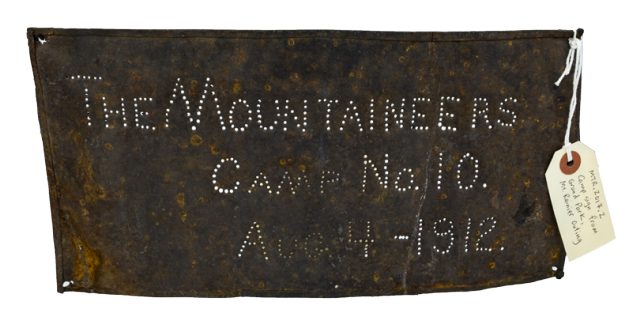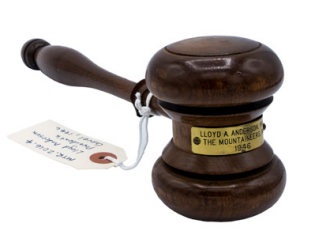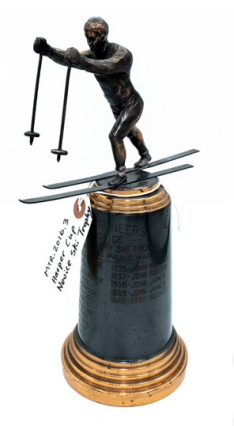
Mount Rainier Summer Outing Camp Sign
Pictured Above
In the first few decades of The Mountaineers existence, members planned long, yearly excursions into the wilderness every summer and winter. On these annual trips, our members ventured into the mountains to explore and discover first ascents on unmapped peaks. In 1912, The Mountaineers spent July 20 - August 10 traveling around Mt. Rainier.
For those early outings, metal signs were created by hand to designate the different camps (following proper decorum of the time, single men and women camped in separate areas, with a family camp set up in between). With lots of members coming along, it’s not hard to imagine the big dinners and nightly fires after a day spent exploring. “One cannot think of a summer's outing without recalling the campfires,” Mary Pashall wrote in our 1912 Annual. “The lost art of storytelling here returns and brings with it original verse and song to fill this breezy chapter of life's outdoor holiday.” By the end of the 1912 trip, our total ascent/descent measured at 50,000 feet, with 139 miles walked. This camp sign was from the group’s 10th camp, which sat at an elevation of approximately 4,500 feet on the north side of Mt. Rainier. The 1912 summer outing was also the first year we reached the summit of Mount Rainier as an organization. “We stood upon the pinnacle of Rainier's icy mantle. A thick haze obscured the horizon,” wrote E.M. Hack. “The utmost heights of Hood, St. Helens, and Adams pierced the cloud canopy and appeared as floating islands in a sea mist.”
Lloyd Anderson’s Gavel
Lloyd Anderson is best known as the co-founder of REI and his search for cheaper, better quality climbing equipment. Lloyd's quest began with an ice ax for a Basic Climbing Course led by Wolf Bauer, who was pioneering new techniques with The Mountaineers. The increasingly technical climbing required new, more advanced tools than traditional hobnail boots and alpenstocks (a long, wooden shaft). Not finding anything locally, he and his wife Mary ordered from Europe, soon establishing themselves as the go-to source for gear. Lloyd and Mary launched the cooperative for $5 in 1938 while operations remained in their West Seattle attic (Lloyd, Mary, and three other Mountaineers members put in $1 each). "In 1942 the club moved to 523 ½ Pike Street, just above the Green Apple Pie Café. Soon thereafter, Lloyd Anderson moved his fledgling Recreational Equipment Cooperative down the hall, thereby establishing a kind of Mountaineers Central," reads one caption in Jim Kjeldsen's The Mountaineers: A History. Lloyd eventually went on to become President of The Mountaineers in 1946, perhaps using this gavel to keep more than a few committee meetings on schedule after a bit of storytelling.
 Photo by Trevor Dickie
Photo by Trevor Dickie
Harper Novice Cup Ski Trophy
As one of our earliest skiing trophies, the Harper Novice Cup was known for the spectacle rather than the skill. “It became the highlight of the winter sports season, probably due to the drama and comedy in a mass of beginning skiers trying to negotiate a race course,” Jim Kjeldsen wrote in The Mountaineers: A History. The trophy was introduced in 1923 for men, after the success of an earlier competition, featuring women cross-country skiers with less than twoand-a-half seasons of experience. The 1929 edition of The Mountaineer Annual – designated as a special ski-focused volume – detailed the race, “The course is to run from a point near Snoqualmie Lodge to a mark at or near the U. S. Geological Survey “hub” at the summit of Snoqualmie Pass, and return, with points given for speed, less one point for every fall experienced en-route.” If you look closely, you might just recognize that last name on the trophy, inscribed as the 1940 champion.
 Photo by Trevor Dickie
Photo by Trevor Dickie
This article originally appeared in our Spring 2019 issue of Mountaineer Magazine. To view the original article in magazine form and read more stories from our publication, click here.
 Trevor Dickie
Trevor Dickie